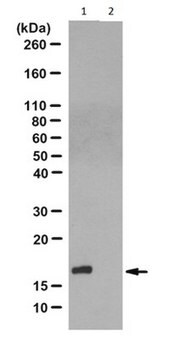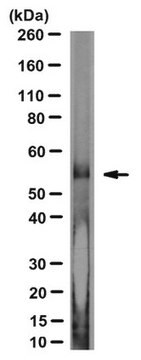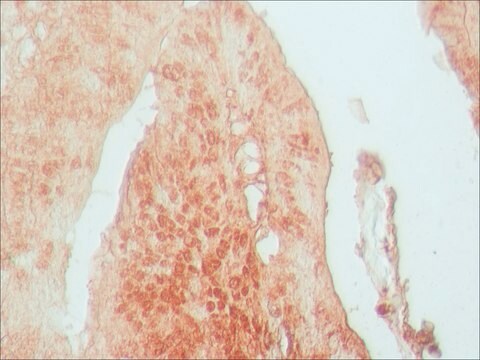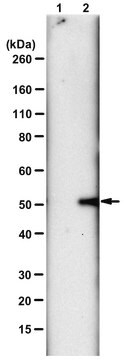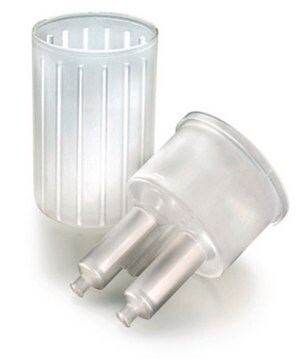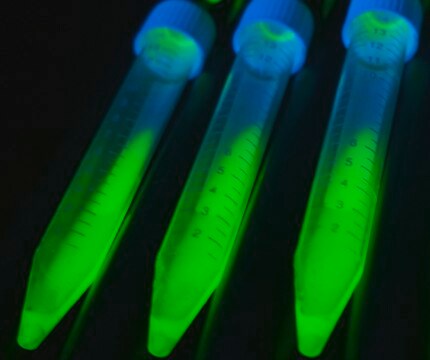ABS1670
Anti-Phosphohistidine (pHis)
from rabbit, purified by affinity chromatography
Sinônimo(s):
pHis, phosphohistidine
About This Item
Produtos recomendados
fonte biológica
rabbit
Nível de qualidade
forma do anticorpo
affinity isolated antibody
tipo de produto de anticorpo
primary antibodies
clone
polyclonal
purificado por
affinity chromatography
reatividade de espécies
all, human, sheep, mouse
técnica(s)
ELISA: suitable
dot blot: suitable
immunoprecipitation (IP): suitable
western blot: suitable
Condições de expedição
ambient
modificação pós-traducional do alvo
phosphorylation (pHis )
Informações sobre genes
human ... PHPT1(29085)
Descrição geral
Especificidade
Imunogênio
Aplicação
Western Blotting Analysis: A 1:120 dilution from a representative lot detected proteins with histidine phosphorylation in sheep trachea cytosolic extract and human cell lysates, including 16HBE14o-, HEK293T, THP-1, and THP-1-derived macrophages (Courtesy of Bezaleel Mambwe, Richmond Muimo and RFW Jackson, Department of Infection, Immunity and Cardiovascular Disease/ Department of Chemistry, University of Sheffield, UK).
ELISA Analysis: A representative lot detected pHis- and pPza-, but not pTyr-, pSer-, pThr-, conjugated BSA or unconjugated BSA (Lilley, M., et al. (2015). Chem. Commun. (Camb). 51(34):7305-7308).
Immunoprecipitation Analysis: A representative lot immunoprecipitated proteins with histidine phosphorylation from ovine airway epithelia extract (Lilley, M., et al. (2015). Chem. Commun. (Camb). 51(34):7305-7308).
Western Blotting Analysis: A representative lot detected histidine phosphorylated proteins in 16HBE14o- human bronchial epithelial cell lysate and in ovine airway epithelia extract. Acid (0.1 M HCl or 0.4 M acetic acid/0.1 M hydroxylamine), but not alkaline (0.1 M NaOH), treatment of the lysates abolished targets bands detection (Lilley, M., et al. (2015). Chem. Commun. (Camb). 51(34):7305-7308).
Western Blotting Analysis: A representative lot detected histidine phosphorylation of immunoprecipitated NDPK-A/B from ovine airway epithelia extract, as well as G -R/M from 16HBE14o- human bronchial epithelial cell lysate (Lilley, M., et al. (2015). Chem. Commun. (Camb). 51(34):7305-7308).
Note: DO NOT HEAT SAMPLES prior to phosphohistidine detection. Histidine phosphorylation is heat and acid labile. To generate negative control for specificity test, an aliquot of sample can be heated at 95ºC for 10-15 minutes to reverse histidine phosphorylation. Alternatively, an aliquot of sample can be incubated under acidified pH at 37ºC for 15 minunites to reduce histidine phosphorylation. Acidify each 100 µL sample with 25 µL of 1 M HCl before the incubation, then neutralize with 25 µL of 1 M NaOH prior to phosphohistidine detection.
Signaling
Qualidade
Western Blotting Analysis: A 1:200 dilution of this antibody detected histidine-phosphorylated proteins in 10 µg of HEK293 cell lysate.
Descrição-alvo
forma física
Armazenamento e estabilidade
Outras notas
Exoneração de responsabilidade
Não está encontrando o produto certo?
Experimente o nosso Ferramenta de seleção de produtos.
Código de classe de armazenamento
12 - Non Combustible Liquids
Classe de risco de água (WGK)
WGK 1
Ponto de fulgor (°F)
Not applicable
Ponto de fulgor (°C)
Not applicable
Certificados de análise (COA)
Busque Certificados de análise (COA) digitando o Número do Lote do produto. Os números de lote e remessa podem ser encontrados no rótulo de um produto após a palavra “Lot” ou “Batch”.
Já possui este produto?
Encontre a documentação dos produtos que você adquiriu recentemente na biblioteca de documentos.
Nossa equipe de cientistas tem experiência em todas as áreas de pesquisa, incluindo Life Sciences, ciência de materiais, síntese química, cromatografia, química analítica e muitas outras.
Entre em contato com a assistência técnica